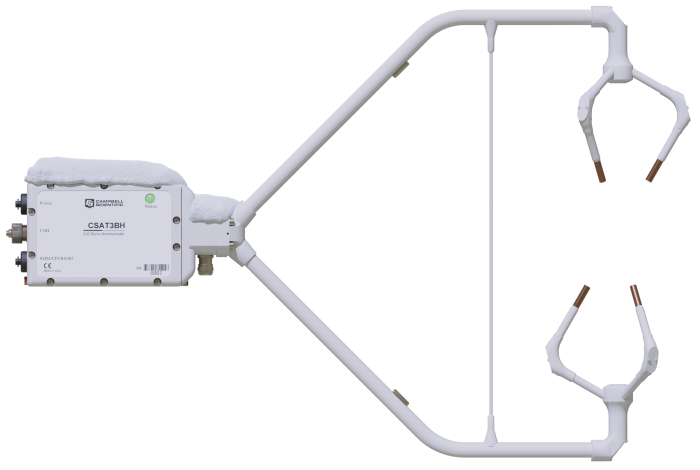概要
CSAT3BHは、電子機器を内蔵したCSAT3B 3D超音波風速計の加熱バージョンです。CSAT3BHの仕様は、風の測定に関してはCSAT3Bと同じです。
続きを読む利点と特徴
- 新しいコンフォーマルコーティングにより、腐食環境下でも音波振動子を保護
- 音速風速計の振動子と本体を雪や氷から守る2ゾーンヒーター
- 環境フィードバックを利用した加熱コントローラにより、電力予算を確保
- 音波空気力学を確実に維持するための合理化されたヒーター統合
- 統合されたデータフラグにより、ヒーターが動作しているときに重要な情報を提供
イメージ








詳細
CSAT3BHは、統合された2ゾーンスマートヒーターを提供します:
- ゾーン1はアームと支柱
-
ゾーン2はすべてのトランスデューサを加熱します
物理的
電気的
ヒーターは2つのゾーンで制御され、フルパワーで150Wを必要とします。コントローラは、センサ上に氷が形成されないように、適切なワット数を得るために電圧を増減してヒーターを制御します。
仕様
| センサ | 3次元超音波風速計 |
| 測定の説明 | 最高品質の風速と風向 |
| 動作温度範囲 | -40 ~ +50°C (音速305~368 m s-1に相当) |
| 出力 | ux, uy, uz, Ts 「(ux, uy, uz は風速計の軸を基準とした風の成分です。Tsは摂氏での音速温度です。)」 |
| 音速 | 3 つの音響経路から決定されます。 (横風の影響を補正) |
| 風向範囲 | CSAT3B座標系で2.5~357.5度 (0~360°カスタマイズ可能) |
| フィルタ帯域幅 | 5, 10, 20, 25 Hz |
| 測定経路長 | 「縦 10.0 cm (3.9 インチ)、横 5.8 cm (2.3 インチ)」 |
| 水平からのトランスデューサ角度 | 60度 |
| トランスデューサ直径 | 0.64 cm (0.25 in.) |
| トランスデューサ取り付けアーム直径 | 0.84 cm (0.33 in.) |
| サポートアーム直径 | 1.59 cm (0.63 in.) |
| 風速計ヘッド重量 | 1.9 kg (4.2 lb) |
| 風速計の寸法 | 63.1 x 12.3 x 43.3 cm (24.8 x 4.9 x 17.0 in.) |
電源/消費電流 |
|
| 電圧供給 | 9.5 ~ 32 Vdc |
| 10 Hz 測定レートでの消費電流 |
|
| 100 Hz 測定レートでの消費電流 |
|
| ヒータ | 6.2 A (@ 24 Vdc) |
| アームと支柱 |
|
| トランスデューサ先端部 |
|
| 総システム消費電流 |
|
| コントローラに必要な電流 | 30 mA (ヒーターオフ [静止] @ 24 Vdc) |
風の正確度 |
|
| -注意- |
精度仕様では以下を前提としています:
|
| 最大オフセット誤差 | < ±8.0 cm s-1 (ux, uy), < ±4.0 cm s-1 (uz) |
| 最大ゲイン誤差 |
|
測定分解能 |
|
| ux, uy | 1 mm s-1 RMS |
| uz | 0.5 mm s-1 RMS |
| Ts | 0.002°C RMS (@ 25°C) |
| 風向 | < 0.058° (ux = uy ≤ 1 m s-1) |
測定レート |
|
| データロガートリガー | 1 ~ 100 Hz |
| プロンプトなしの出力(PC へ) | 10, 20, 50, 100 Hz |
| 内部自己トリガーレート | 100 Hz |
測定遅延 |
|
| データロガートリガー(フィルターなし) | 1 トリガー期間 (1スキャン間隔) |
| プロンプトなしの出力(フィルターなし) | 10 ms |
| フィルタリングされた出力(データロガーからのプロンプトまたは PC へのプロンプトなし) |
|
内部モニタ測定 |
|
| 更新レート | 2 Hz |
| 傾斜計の正確度 | ±1° |
| 相対湿度計の正確度 |
|
| ボード温度正確度 | ±2°C |
SDM |
|
| -注意- | データロガーベースのデータ取得に使用されます。 |
| ビット周期 | 10 µs ~ 1 ms |
| ケーブル長 |
|
| アドレス範囲 | 1 ~ 14 |
| サンプルあたりのバスクロック | ~200 |
CPI |
|
| -注意- | データロガーベースのデータ取得に使用されます。 |
| ボーレート | 50 kbps ~ 1 Mbps |
| ケーブル長 |
|
| アドレス範囲 | 1 ~ 120 |
| サンプルあたりのバスクロック | ~300 |
RS-485 |
|
| -注意- | 本体設定または PC ベースのデータ取得に使用されます。 |
| ボーレート | 9.6 kbps ~ 115.2 kbps |
| ケーブル長 |
|
| サンプルあたりのバスクロック | ~500 (ASCII形式) |
USB |
|
| -注意- | 本体設定または PC ベースのデータ取得に使用されます。 |
| 接続速度 | USB 2.0 フルスピード 12 Mbps |
| ケーブル長 | 最大5 m (16.4 ft) |
ドキュメント
マニュアル
コンプライアンス
動画とチュートリアル
ダウンロード
CSAT3BH CR1000X Programs v.2.03 (9 KB) 20-11-2020
CR1000X datalogger programs for the CSAT3BH with SDM and CPI communications protocols.
Warning: This program is not intended for the CSAT3H Heater Controller Enclosure. Please contact Campbell Scientific for any questions regarding the CSAT3H Heater Controller program.
CSAT3BH CR6 Programs v.2.03 (9 KB) 20-11-2020
CR6 datalogger programs for the CSAT3BH with SDM and CPI communications protocols.
Warning: This program is not intended for the CSAT3H Heater Controller Enclosure. Please contact Campbell Scientific for any questions regarding the CSAT3H Heater Controller program.
CSAT3H Heater Controller v.14.2 (46 KB) 02-02-2021
The CSAT3H Heater Controller ships with this encrypted program. This program is for the unlikely event that the program needs to be re-installed or updated to a newer version. Please contact Campbell Scientific if you have questions about the program or would like the algorithm modified for a specific application.
よくある質問
CSAT3BHに関するよくある質問の数: 18
すべて展開すべて折りたたむ
-
CSAT3BH は、-40° ~ +50°C の温度範囲で校正されています。アプリケーションでより低い温度要件が必要な場合は、Campbell Scientific にお問い合わせください。
機器は、信号が弱くなりすぎるまで、校正された温度範囲外で動作し続けます。ただし、校正ファイルは指定された温度範囲のみを対象としているため、測定には適切な校正が適用されません。
-
いいえ。オフセットは温度と時間の関数です。年に一度、T3CSAT3B の取扱説明書に記載されている手順を使用して、音波風速計の風オフセットを抜き取り検査してください。測定されたオフセットが仕様外の場合は、校正のためにセンサを工場に返送してください。返品承認 (RMA) 番号をリクエストするには、修理と校正のページに記載されている手順に従ってください。
-
はい。CSAT3B および CSAT3BH の測定周波数は、ユーザーが変更できます。ユーザーは、プロンプト付きまたはプロンプトなしの出力レートを選択できます。プロンプト付き出力レートは、データロガーのスキャン間隔に基づいており、整数である必要があります。したがって、サポートされる測定周波数は、1、2、4、5、8、10、20、25、40、50、および 100 Hz になります。許可されるプロンプトなしの出力レートは、10、20、50、および 100 Hz です。
-
CSAT3A、CSAT3AH、CSAT3B、および CSAT3BH は、トランスデューサの遅延が風速に与える影響、および程度は低いものの音速測定への影響について、温度に対して較正されています。
超音波風速計には NIST 追跡可能な規格はありません。
-
いいえ。音波風速計は風の測定値とともに時間を報告しません。風データには、データロガーまたは PC などのデータ収集システムによってタイムスタンプが割り当てられます。
-
Campbell Scientific では、音波風速計センサ ヘッドを簡単かつ頻繁に配置できる取り付けブームやハードウェアは提供していません。このタイプのハードウェアはユーザーが用意する必要があります。
-
はい。マッチング層が破損または欠落している場合は、修理のために音波風速計を工場に返送してください。修理および校正ページに記載されている手順に従って、返品承認 (RMA) 番号をリクエストしてください。
-
CSAT3A、CSAT3AH、CSAT3B、CSAT3BH は、他の音波風速計と同様に、超音波信号を使用して音波経路に沿った風速を測定します。塩水噴霧によって音波経路が遮断されると、音波風速計は測定できなくなります。トランスデューサの表面に厚い塩の層が堆積した場合も同様です。
-
音速風速計のオフセット仕様は±8 cm/sです。そのため、予想される風速が±5 cm/sの範囲にあるアプリケーションでは使用できません。
記事とプレスリリース
ブログ記事
-
Why Should You Use a Heated Sonic Anemometer?

19-11-2019 著者: Robin Deissinger
Privacy Policy Update
We've updated our privacy policy. 詳細はこちら
Cookie Consent
Update your cookie preferences. クッキーの設定を更新する










